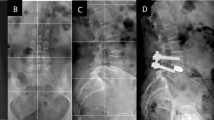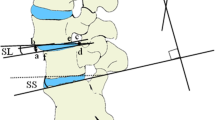Abstract
Purpose
First description of MIS-VLIF, a minimally invasive lumbar stabilization, to evaluate its safety and feasibility in patients suffering from weak bony conditions (lumbar spondylodiscitis and/or osteoporosis).
Methods
After informed consent, 12 patients suffering from lumbar spondylodiscitis underwent single level MIS-VLIF. Eight of them had a manifest osteoporosis, either. Pre- and postoperative clinical status was documented using numeric rating scale (NRS) for leg and back pain. In all cases, the optimal height for the cage was preoperatively determined using software-based range of motion and sagittal balance analysis. CT scans were obtained to evaluate correct placement of the construct and to verify fusion after 6 months.
Results
Since 2013, 12 patients with lumbar pyogenic spondylodiscitis underwent MIS-VLIF. Mean surgery time was 169 ± 28 min and average blood loss was less than 400 ml. Postoperative CT scans showed correct placement of the implants. Eleven patients showed considerable postoperative improvement in clinical scores. In one patient, we observed screw loosening. After documented bony fusion in the CT scan, the fixation system was removed in two cases to achieve lower material load.
Conclusions
The load-bearing trajectories (vectors) of MIS-VLIF are different from those of conventional coaxial pedicle screw implantation. The dorsally converging construct combines the heads of the dorsoventral pedicle screws with laminar pedicle screws following cortical bone structures within a small approach. In case of lumbar spondylodiscitis and/or osteoporosis, MIS-VLIF relies on cortical bony structures for all screw vectors and the construct does not depend on conventional coaxial pedicle screws in the presence of inflamed, weak, cancellous or osteoporotic bone. MIS-VLIF allows full 360° lumbar fusion including cage implantation via a small, unilateral dorsal midline approach.







Similar content being viewed by others
Change history
17 February 2017
An erratum to this article has been published.
References
Klöckner C, Wiedenhöfer B (2012) Therapie der unspezifischen destruierenden Spndylodiszitis unter besonderer Berücksichtigung des sagittalen Profils. Orthopäde 41:736–741
Rutges JPHJ, Kempen DH, Dijk MV et al (2015) Outcome of conservative and surgical treatment of pyogenic spondylodiscitis: a systematic literature review. Eur Spine J. doi:10.1007/s00586-015-4318-y
Nasto LA, Colangelo D, Mazzotta V et al (2014) Is posterior percutaneous screw-rod instrumentation a safe and effective alternative approach to TLSO rigid bracing for single-level pyogenic spondylodiscitis? Results of a retrospective cohort analysis. Spine J 14:1139–1146
Shetty AP, Aiyer SN, Kanna RM et al (2015) Pyogenic lumbar spondylodiscitis treated with transforaminal lumbar interbody fusion: safety and outcomes. Int Orthop. doi:10.1007/s00264-015-3063-5
Shiban E, Janssen I, Wostrack M et al (2014) A retrospective study of 113 consecutive cases of surgically treated spondylodiscitis patients. A single-center experience. Acta Neurochir 156:1189–1196
Patel NB, Dodd ZH, Voorhies J, Horn EM (2015) Minimally invasive lateral transpsoas approach for spinal discitis and osteomyelitis. J Clin Neurosci 22:1753–1757
Harms JG (1998) Jeszenszky D [In Process Citation]. Operative Orthopädie und Traumatologie 10:90–102
Holly LT, Schwender JD, Rouben DP, Foley KT (2006) Minimally invasive transforaminal lumbar interbody fusion: indications, technique, and complications. Neurosurg Focus 20:E6
Scheufler KM, Dohmen H, Vougioukas VI (2007) Percutaneous transforaminal lumbar interbody fusion for the treatment of degenerative lumbar instability. Neurosurgery 60:203–212 (discussion 212–3)
Lin Y, Chen W, Chen A, Li F (2016) Comparison between minimally invasive and open transforaminal lumbar interbody fusion: a metaanalysis of clinical results and safety outcomes. J Neurol Surgery 77:2–10
Reinshagen C, Ruess D, Walcott BP et al (2015) A novel minimally invasive technique for lumbar decompression, realignment, and navigated interbody fusion. J Clin Neurosci 22:1484–1490
Inceoğlu S, Montgomery WH Jr, St Clair S, McLain RF (2011) Pedicle screw insertion angle and pullout strength: comparison of 2 proposed strategies. J Neurosurg Spine 14:670–676
Santoni BG, Hynes RA, McGilvray KC, Rodriguez-Canessa G, Lyons AS, Henson MA et al (2009) Cortical bone trajectory for lumbar pedicle screws. Spine J 9:366–373
Vaidya R, Novel V (2010) Construct and method of spinal stabilization after transforaminal lumbar interbody fusion using the construct. United States Patent Application Publication. US Patent US20100280554 A1‚ 4 nov 2010
Sethi A, Muzumdar AM, Ingalhalikar A, Vaidya R (2011) Biomechanical analysis of a novel posterior construct in a transforaminal lumbar interbody fusion model an in vitro study. Spine J 11(9):863–869. doi:10.1016/j.spinee.2011.06.015
Sethi A, Lee S, Vaidya R (2009) Transforaminal lumbar interbody fusion using unilateral pedicle screws and a translaminar screw. Eur Spine J 18:430–434
Knox JB, Dai JM, Orchowski JR (2011) Superior segment facet joint violation and cortical violation after minimally invasive pedicle screw placement. Spine J 11:213–217
Dettmar-Rieger J(2013) Vektor-Lumbale interkorporelle fusion. DMPA. DE Patent DE 102011119646 A1‚ 27 June 2013
Jeanneret B, Kleinstück F, Magerl F (1995) Die translaminäre Verschraubung der lumbalen Wirbelgelenke. Operative Orthopädie und Traumatologie 7:37–53
Cho W, Cho SK, Wu C (2010) The biomechanics of pedicle screw-based instrumentation. J Bone Joint Surg 92:1061–1065
Matsukawa K, Yato Y, Imabayashi H et al (2016) Biomechanical evaluation of lumbar pedicle screws in spondylolytic vertebrae: comparison of fixation strength between the traditional trajectory and a cortical bone trajectory. J Neurosurg: Spine. doi:10.3171/2015.11.SPINE15926
Wang Z, Sakakibara T, Yoshikawa T et al (2013) Do the position and orientation of the crosslink influence the stiffness of spinal instrumentation? J Spinal Disord Tech. doi:10.1097/BSD.0000000000000046
Author information
Authors and Affiliations
Corresponding author
Ethics declarations
Conflict of interest
There is no conflict of interests.
Additional information
B. Rieger and H. Jiang contributed equally.
An erratum to this article is available at https://doi.org/10.1007/s00586-017-4992-z.
Rights and permissions
About this article
Cite this article
Rieger, B., Jiang, H., Ruess, D. et al. First clinical results of minimally invasive vector lumbar interbody fusion (MIS-VLIF) in spondylodiscitis and concomitant osteoporosis: a technical note. Eur Spine J 26, 3147–3155 (2017). https://doi.org/10.1007/s00586-016-4928-z
Received:
Revised:
Accepted:
Published:
Issue Date:
DOI: https://doi.org/10.1007/s00586-016-4928-z




